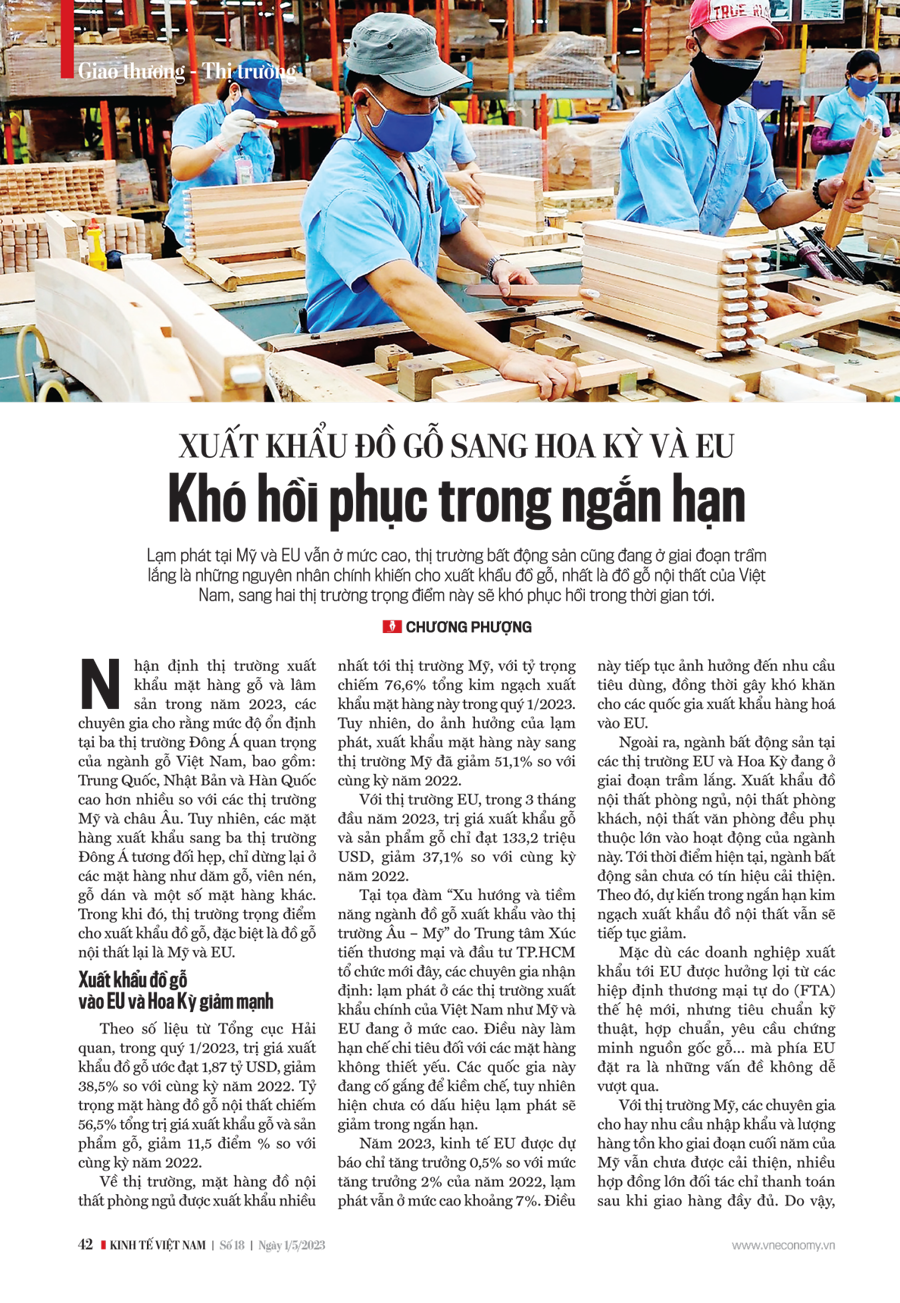[ad_1]
Assessing the timber and forest products export market in 2023, experts say that the level of stability in three major East Asian markets of Vietnam’s timber industry, including: China, Japan and Korea, is much higher than in the US and European markets. However, export items to the three East Asian markets are relatively narrow, stopping only at items such as wood chips, pellets, plywood and a few other items. Meanwhile, the main markets for wooden furniture exports, especially furniture, are the US and the EU.
TIMBER EXPORTS TO THE EU AND THE USA STRONGLY REDUCED
According to the General Department of Customs, the export value of wooden furniture was estimated at US$1.87 billion in the first quarter of 2023, down 38.5% from the same period in 2022. The share of wooden furniture products made 56.5%. of the total export value of wood and wood products by 11.5 percentage points compared to the same period in 2022.
In terms of market, bedroom furniture was the most exported to the US market, accounting for 76.6% of the total export sales of this item in the first quarter of 2023. However, due to the influence of inflation, the export of this item to the US market decreased by 51.1% compared to the same period in 2022.
For the EU market, the export value of timber and timber products reached only USD 133.2 million in the first 3 months of 2023, down 37.1% from the same period in 2022.
At the seminar “Trends and potentials of the wooden furniture industry for export to the European-American market” held recently by the Center for Trade and Investment Promotion of Ho Chi Minh City, experts said: Inflation in the markets of Vietnam’s main export markets as z USA and EU are at a high level. This limits spending on non-essential items. These countries are trying to contain it, but there is no sign of inflation in the short term.
In 2023, the EU economy is expected to grow by just 0.5% compared to the 2% growth rate in 2022, inflation is still high at around 7%. This continues to affect consumer demand while making it more difficult for countries to export goods to the EU.
In addition, the real estate industry in the EU and US markets is in a quiet phase. The export of bedroom furniture, living room furniture and office furniture is highly dependent on the activities of this industry. So far, the real estate industry has not shown any signs of improvement. Accordingly, furniture export sales are expected to continue to decline in the short term.
Although companies exporting to the EU benefit from new generation Free Trade Agreements (FTAs), the technical standards, conformity, requirements for proof of timber origin etc. set by the EU side are problems that are not easy to overcome.
With the US market, experts said that US import demand and inventories did not improve in the year-end period, many large contracts with partners only pay after full delivery. Therefore, Vietnam’s wooden furniture exports to the US market are unlikely to grow in the short term. Alongside this, there are a number of difficulties that timber industry companies face, such as US fiscal and monetary policies, high inflation, high logistical transportation costs, and federal government regulations, particularly in relation to quarantine, labor standards…
PAST HOPE IN EVFTA
Mr Nguyen Tuan, deputy director of Ho Chi Minh City Trade and Promotion Center (ITPC), said the EU is an area with furniture consumption accounting for 25% of global total demand and a growth rate of 4.5% per year. Although furniture imports to the EU area have grown rapidly, the amount of furniture imported into the EU from Vietnam is still very small.
In 2022, Vietnamese furniture exports to the EU accounted for only 1.9% of the total EU import turnover of this item. In the long term, Vietnamese companies in the timber industry therefore still have a lot of leeway to expand their market share in the EU.
In addition, the EU-Vietnam Free Trade Agreement (EVFTA) has a positive impact on the timber industry and creates a competitive advantage as the tax rate is gradually reduced to 0%. This also creates an investment attraction from the EU to Vietnam.
EVFTA, entering its third year of existence, is identified as the driving force behind promoting Vietnam’s exports to the EU market. Vietnam is one of four countries that have trade agreements with the EU in Asia. EU trade policy focuses on these countries in order to remove difficulties for the internal market. These are also factors that will help Vietnam have more opportunities to increase exports to the EU.
The content of the article was published in Vietnam Economic Review No. 18-2023, issued on May 1, 2023. Welcome readers to read The:
https://postenp.phaha.vn/chi-tiet-toa-soan/tap-chi-king-te-viet-nam

[ad_2]
Source link

